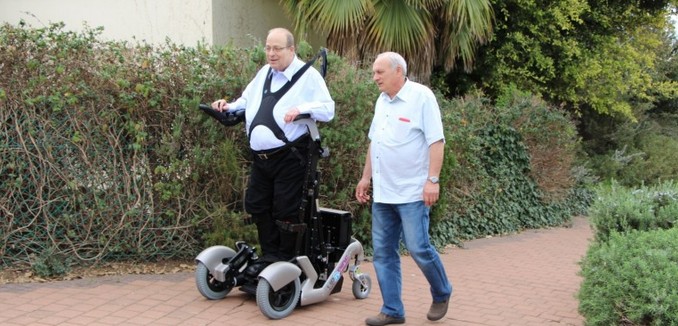Nearly everyone knows about ReWalk, the revolutionary robotic exoskeleton invented in Israel that allows paraplegics to stand, walk, and even navigate steps and run marathons.
Ironically, ReWalk inventor Amit Goffer cannot use his own device because he is a quadriplegic, paralyzed from the neck down following an accident in 1997. But last summer he was finally able to leave home in an upright position, riding the most recent of his inventions — the alpha model of the UPnRIDE.
The first commercial model, UPnRIDE 1.0, will be unveiled at the Rehacare International trade fair in Düsseldorf at the end of September.
“I have had a long-standing vision that all people confined to a wheelchair should have access to enhanced mobility, and enjoy the many health benefits associated with the ability to transition to a standing position,” Goffer said. “With the introduction of UPnRIDE, that dream has become a reality.”
The UPnRIDE mobility device is suitable for most wheelchair and scooter users, including paraplegics, quadriplegics, and people suffering from multiple sclerosis, cerebral palsy, or traumatic brain injury.
A set of jointed braces and harnessing straps provides support when transitioning between sitting and standing positions. Cutting-edge motion technology and real-time computing ensures automatic balancing and stability when UPnRIDE maneuvers on sloped sidewalks, parking lots, and ramps, maintaining a constant center of gravity to minimize risk of hazards.
“There are other standing wheelchairs available on the market,” said Oren Tamari, CEO of UPnRIDE Robotics, based in Yokneam Illit in northern Israel. “But UPnRIDE is unique in that it provides users with full, safe, functional mobility in an upright position in practically any urban environment, both indoors and outdoors.”
“By enabling upright mobility, UPnRIDE delivers numerous health, economic and societal benefits. It shifts attention away from the disability, providing wheelchair users with a fresh, new perspective of the world, of themselves and of life.”
A standing position provides exercise for paralyzed limbs and alleviates many health problems associated with long-term wheelchair. In addition, UPnRIDE could slash healthcare expenses for insurers, hospitals, patients, and their families.
“After we brought the ReWalk to market, there were still millions of people with walking impairments, who couldn’t use it, and who were seeking an upright mobility solution,” noted Goffer.
“Despite the known detrimental impact of sedentary wheelchairs on physical and mental health, and on productivity and social inclusion, until recently, traditional wheelchairs were still the standard means for mobility. By shifting the default mobility position to standing, UPnRIDE constitutes the first real revolution in the wheelchair industry.”
Tamari says UPnRIDE Robotics is currently raising Series B funds, completing development, and applying for regulatory clearance for marketing. “Our plan, by early 2017, is to have the first users ride the UPnRIDE, and we are confident that they will have a truly life-changing experience.”
(via Israel21c)
[Photo: Israel21c ]




